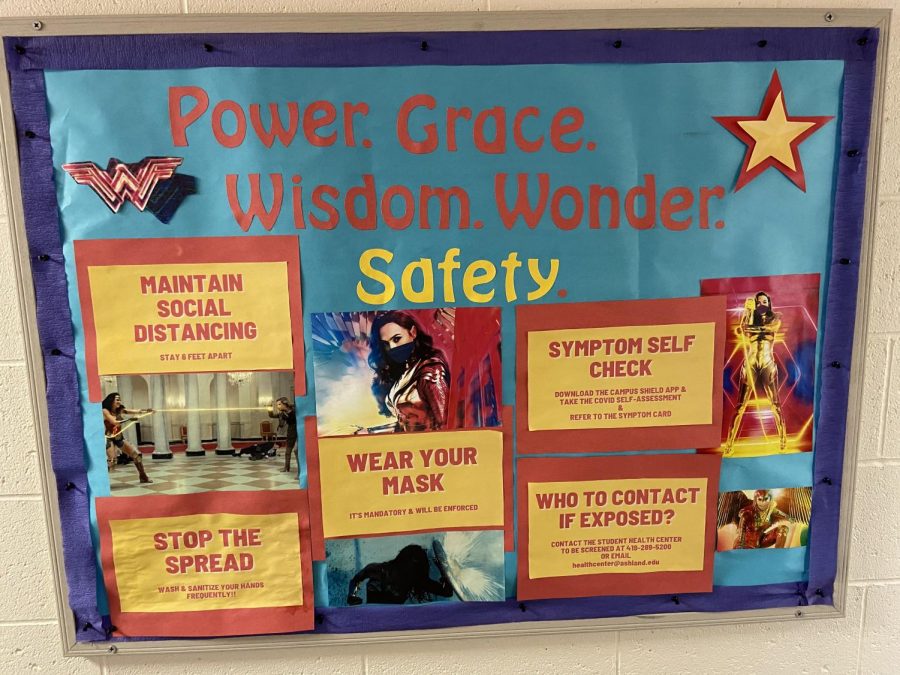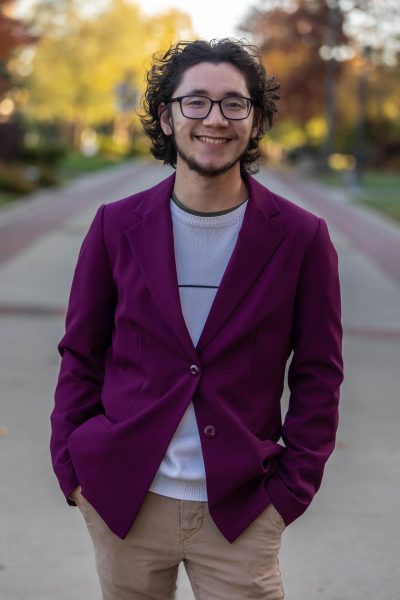Student compliance to COVID-19 policy is sub-par
Residence hall bulletin board details COVID-19 regulations and policy on campus.
October 2, 2020
Ashland University has made it clear that the goal of a safe and healthy academic year throughout the coronavirus pandemic is envisioned by the “Stronger Together, Safer Together” initiative. This initiative has set in place protocol and guidelines to be followed by all students, faculty and staff in and around campus.
These guidelines are meant to help ensure proper social distancing and the health and safety of the community: reducing the number of seating in classrooms, following floor markings and tape throughout social/dining areas, placing limitations on group gatherings, and wearing masks around campus and in all buildings. Although Ashland plans for its students to stay on campus as long as they can, the university’s enforcement of these guidelines hasn’t been well-received.
It is obvious that being able to socially distance in a tight space, such as an elevator, can be difficult. In order to combat this, Ashland has made it so that there can be no more than two people in one elevator at a time. As someone who is not a fan of a crowded elevator, this guideline came natural to me.
However, many students are starting to ignore some, if not, all guidelines for COVID protocol. Which is not difficult since Ashland’s enforcement of said protocol has not been meeting the standards that should be met. It seems that many of the students, faculty and staff are entirely over the pandemic and feel above it.
There have been many times in my dorm hall, where other students will crowd in the elevator with me, most not even acknowledging the protocol or asking for consent to have more than two. In dorms, students are only allowed one guest per person living in the room, however, on multiple occasions, I have seen more than the allotted people gathering in the same or different dorms. Not only is this activity risking the health of the campus, these gatherings can generate unnecessary noise, making those in and around the dorm building find difficulty focusing and studying.
The dining halls have had the most changes done. Seating has been spaced out and the number of seats has been split in half, access to self-serve items has been removed, and lines have been adjusted to account for six-foot spacing. Even though chairs are clearly spaced out, students will still drag multiple chairs to tables that would normally only fit about five people. Along with this, those dining do not wear their masks as often as they should– although masks are allowed to be taken off to eat or drink, many people will leave their mask off around the entirety of the dining area.
Even those who wear their masks do not properly wear them. People have different ideas about what is safe or smart or the best way to approach this pandemic, and others do not understand the best way to approach this pandemic seriously and appropriately. I genuinely do not understand what is so difficult about wearing a mask around a group of people. Some people do have medical issues like asthma which can conflict with wearing a mask.
However, most people I have talked to about wearing their masks said simply that they “just don’t want to.”
It seems to me that since there have been so many changes done, that those enforcing it cannot even keep up with their own protocol. The execution of Ashland’s response to COVID and the protocol they set in place has been sloppy and unorderly, contradicting the smooth transition to normalcy the university was hoping for.
Even the lines set in place for social distancing are sloppy– particularly the Grubhub pick-up window at Eagle’s Nest. Orders at the window pile up, forcing students to jumble together to get their orders.
I do not believe Ashland is trying its hardest to keep students on campus, nor do I believe that students are following enough rules to stay on campus. Ashland University says that we are taking COVID seriously and taking every precaution to ensure the health and safety of every student, faculty and staff member, however I just do not see that commitment from either side.
Both sides of the equation are not doing their part, making the possibility of staying on campus start to become smaller and smaller. All on-campus students say that they do not want to have to go home and continue with remote instruction online. However, these same students will not follow these simple guidelines designed to keep them on campus for as long as possible. In the end, if Ashland University and its students, faculty and staff want to remain on campus, these guidelines need to be enforced a lot more than they have been and students must learn to listen and follow them. Otherwise, what’s the point of going to college?




